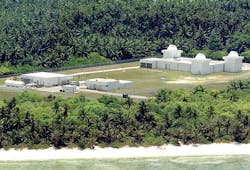Serco eyes space surveillance system to track objects ranging from satellite sensor payloads to space junk
PETERSON SPACE FORCE BASE, Colo. – Electronics experts at Serco North America in Herndon, Va., will sustain an important U.S. space surveillance system under terms of an $8.7 million order announced earlier this month.
Officials of the U.S. Space Force Space Acquisition and Integration Office at Peterson Space Force Base, Colo., are asking Serco for option year three from 1 May 2023 through 30 April 2024, for operations and maintenance support for the Ground-based Electro-optical Deep Space Surveillance System (GEODSS).
The GEODSS tracks space objects such as high-orbit satellites from its three global sites in Socorro, N.M.; Maui, Hawaii; and the island of Diego Garcia in the Indian Ocean. The system tracks more than 2,5000 objects like geostationary communication satellites, which vary in altitude in space from 6,214 miles to nearly 28,000 miles above the Earth's surface.
GEODSS tracks space objects ranging from active satellite sensor payloads like weather monitoring satellites or Global Positioning System satellites, to space junk like rocket bodies from previous satellite launches or debris from past satellite breakups.
Each GEODSS site uses three one-meter telescopes with sensitive digital cameras to keep track of high-altitude space objects. These telescopes can see objects 10,000 times dimmer than the human eye can detect.
The GEODSS electro-optical telescopes take rapid electronic snapshots of satellites in the night sky, which show up on the operator’s console as tiny streaks. Computers then measure these streaks and compute the position of satellites in their orbits. Star images, which remain fixed, function as reference or calibration points for each of the three telescopes.
The GEODSS system has been an important piece of the space situational awareness mission since the early 1980s. Serco won a $7.7 million order to sustain GEODSS in February 2021; an $8.5 million GEODSS order in April 2022, and this $8.7 million GEODSS order this month.
Over its life cycle, companies chosen to sustain GEODSS have included Northrop Grumman Corp., L3 Harris Technologies, and Serco.
On this order Serco will do the work in Socorro, N.M.; Diego Garcia, British Indian Ocean Territory; and Maui, Hawaii, and with options should be finished in October 2027.For more information contact Serco North America online at www.serco.com, or the Space Acquisition and Integration Office at www.safsq.hq.af.mil.
About the Author
John Keller
Editor-in-Chief
John Keller is the Editor-in-Chief, Military & Aerospace Electronics Magazine--provides extensive coverage and analysis of enabling electronics and optoelectronic technologies in military, space and commercial aviation applications. John has been a member of the Military & Aerospace Electronics staff since 1989 and chief editor since 1995.
